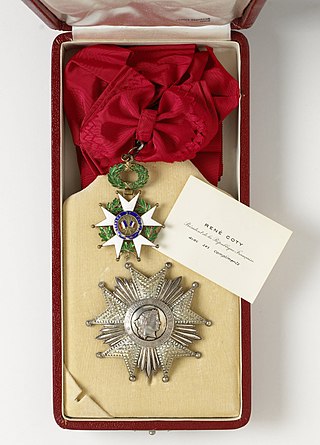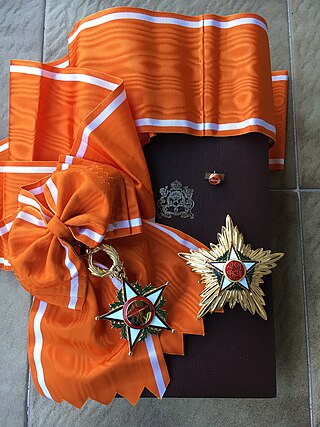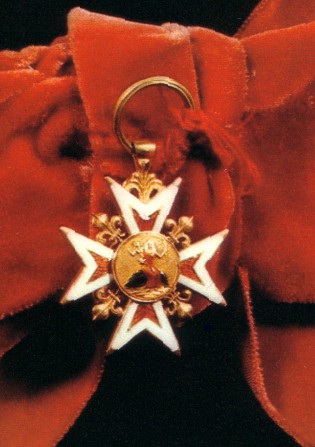
The National Order of the Legion of Honour, formerly the Royal Order of the Legion of Honour, is the highest French order of merit, both military and civil. Established in 1802 by Napoleon Bonaparte, it has been retained by all later French governments and regimes.

The Most Distinguished Order of Saint Michael and Saint George is a British order of chivalry founded on 28 April 1818 by George, Prince of Wales, while he was acting as prince regent for his father, King George III. It is named in honour of two military saints, Michael and George.

The Order of Ouissam Alaouite or the Sharifian Order of Al-Alaoui is a military decoration of Morocco which is bestowed by the King of Morocco upon those civilians and military officers who have displayed heroism in combat or have contributed meritorious service to the Moroccan state. The decoration was established on 11 January 1913 in replacement of the Order of Ouissam Hafidien. It is awarded in five classes: Grand Cordon, Grand Officer, Commander (Commandeur), Officer (Officier) and Knight (Chevalier).

The Order of Leopold is one of the three current Belgian national honorary orders of knighthood. It is the oldest and highest order of Belgium and is named in honour of its founder, King Leopold I. It consists of a military, a maritime and a civil division. The maritime division is only awarded to personnel of the merchant navy, and the military division to military personnel. The decoration was established on 11 July 1832 and is awarded by Royal decree.

The Military William Order, or often named Military Order of William, is the oldest and highest honour of the Kingdom of the Netherlands. It is named after St. William of Gellone (755–814), the first Prince of Orange. Its motto is Voor Moed, Beleid en Trouw. The chivalric order was established on 30 April 1815 by King William I and was presented for feats of excellent bravery on the battlefield and as a meritorious decoration to senior military officers. Comparable with the French Légion d’Honneur but far less often awarded, it is open to everyone regardless of rank or nobility—not only to Dutch military, but also to foreigners. To date, membership in the Order is extremely rarely awarded, and only for exceptional bravery in battle.

The Order of Saint Lazarus of Jerusalem, also known as the Leper Brothers of Jerusalem or simply as Lazarists, was a Catholic military order founded by Crusaders around 1119 at a leper hospital in Jerusalem, Kingdom of Jerusalem, whose care became its original purpose, named after its patron saint, Lazarus. It was recognised by King Fulk in 1142 and canonically recognised as a hospitaller and military order of chivalry under the rule of Saint Augustine in the Papal bull Cum a Nobis Petitur of Pope Alexander IV in 1255. Although they were centred on their charism of caring for those afflicted with leprosy, the knights of the Order of Saint Lazarus notably fought in the Siege of Acre in 1191, Arsuf, and in the 1192 Battle of Jaffa. Battle of La Forbie in 1244 and in the Defense of Acre in 1291. The titular seat was successively situated at Jerusalem, then Acre. After the fall of the Kingdom of Jerusalem, the order split into two main branches – in Italy and in France.

The Order of Civil and Military Merit of Adolph of Nassau is an order of merit of the Grand Duchy of Luxembourg for meritorious service to the Grand Duke, the Grand-Ducal House and Luxembourg. It was founded in 1858 as a chivalric order of the Duchy of Nassau by Adolphe of Nassau in honor of his namesake and ancestor, Adolf, Count of Nassau, the only member of the House of Nassau to have been Roman King of Germany. After the Duchy of Nassau was annexed by Prussia in 1866 and Adolphe became Grand Duke of Luxembourg in 1890, he revived the order as an order of merit.

An order of chivalry, order of knighthood, chivalric order, or equestrian order is an order of knights, typically founded during or inspired by the original Catholic military orders of the Crusades and paired with medieval concepts of ideals of chivalry.

The Order of the Holy Spirit, is a French order of chivalry founded by Henry III of France in 1578. Today, it is a dynastic order under the House of France.
Commander, or Knight Commander, is a title of honor prevalent in chivalric orders and fraternal orders.
The Noble Order of Saint George of Rougemont was a baronial order of chivalry established around 1440 in the Free County of Burgundy. From the 15th through the late 18th centuries it enjoyed the protection of the Dukes of Burgundy and later the French kings. It was abolished in the wake of the French Revolution and became extinct after the death of the last knight in 1869.

The Order of the Crown of Westphalia was instituted in Paris on 25 December 1809 by King Hieronymus I of Westphalen, better known as Napoleon's brother Jérôme Bonaparte. The motto of the Order was "CHARACTER UND AUFRICHTIGKEIT". At the back stood the words "ERRICHTET DEN XXV DEZEMBER MDCCCIX".
This page is a list of the orders of chivalry and orders of merit awarded by France, in the order they were established or incorporated in France, and their origins.

The Order of Tahiti Nui was established on 5 June 1996 by the Assembly of French Polynesia to reward distinguished merit and achievements in the service to French Polynesia.

Jean Thurel, or Jean Theurel, was a fusilier of the French Army and a centenarian with an extraordinarily long career that spanned over 75 years of service in the Touraine Regiment. Born in the reign of Louis XIV and dying during that of Napoleon I, Thurel lived in three different centuries.
The Order of Military Merit, which was initially known as the Institution of Military Merit, was a French military order that was created on 10 March 1759 by King Louis XV for non-Catholic military officers who had assisted the French state.

The Order of Our Lady of Mount Carmel was founded in 1608 by Pope Paul V at the request of King Henry IV of France.

The Military and Hospitaller Order of Saint Lazarus of Jerusalem is a Christian order that was statuted in 1910 by a council of Catholics in Paris, France, initially under the protection of Patriarch Cyril VIII Geha of the Melkite Greek Catholic Church. During the 1920s, it expanded its jurisdiction and enrolled members from other countries in Europe and in the Americas. It re-established the office of grand master in 1935, linking the office to members of the Spanish branch of the House of Bourbon. It assumed an ecumenical dimension during the 1950s to expand its membership to individuals of other Trinitarian Christian denominations in British Commonwealth countries.

The Ordre national du Mérite is a French order of merit with membership awarded by the President of the French Republic, founded on 3 December 1963 by President Charles de Gaulle. The reason for the order's establishment was twofold: to replace the large number of ministerial orders previously awarded by the ministries; and to create an award that can be awarded at a lower level than the Legion of Honour, which is generally reserved for French citizens. It comprises about 185,000 members; 306,000 members have been admitted or promoted in 50 years.

The Ordre du Mérite militaire was a ministerial order of merit of France created on 22 March 1957 to recognize the contributions of active members of the military reserves during times of peace. The order was administered and awarded the Ministry of Defence. The order was created to replace the Croix des services militaires volontaires established in 1934. Holders of the Cross were made members of the Ordre du Mérite militaire, bronze holders as knights, silver holders as officers, and gold holders as commanders.
























